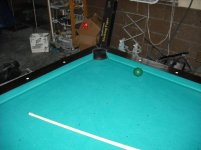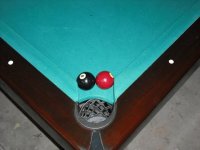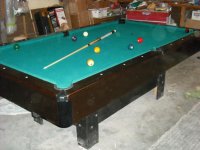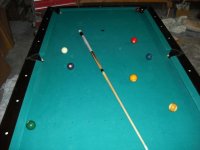You are using an out of date browser. It may not display this or other websites correctly.
You should upgrade or use an alternative browser.
You should upgrade or use an alternative browser.
Why do pool tables have slate?
- Thread starter ChopStick
- Start date
OTLB
Banned
It seems to me that they could be made more accurate by having the bed made of aluminum or titanium alloys. You could eliminate the sagging and the sensitivity to moisture.
slate is cheap, its simple and it works
It seems to me that they could be made more accurate by having the bed made of aluminum or titanium alloys. You could eliminate the sagging and the sensitivity to moisture.
Price a sheet of even just steel that size and you will be surprised
Aluminum or titanium would be more expensive yet
Price a sheet of even just steel that size and you will be surprised
Aluminum or titanium would be more expensive yet
I think I will. They want to charge $1,000 or so for slate. I am just tired of all the problems with slate. I have never seen a table that you could level out perfectly. Even if you get it level, it won't stay that way. My last two tables were Diamonds.
I found some 1/2 inch 36" x 48" aluminum plate for $527. Stainless steel is about twice as much. Titanium is ridiculous. $3,900. 48 inches seems to be the maximum standard size. Trying to find it in pool table sizes could be hard and more expensive. I may do it anyway.
Last edited:
I think I will. They want to charge $1,000 or so for slate. I am just tired of all the problems with slate. I have never seen a table that you could level out perfectly. Even if you get it level, it won't stay that way. My last two tables were Diamonds.
I found some 1/2 inch 36" x 48" aluminum plate for $527. Stainless steel is about twice as much. Titanium is ridiculous. $3,900. 48 inches seems to be the maximum standard size. Trying to find it in pool table sizes could be hard and more expensive. I may do it anyway.
But wouldn't one need a frame made out of steel because isn't it usually the frame that absorbs or releases moisture and causes the table to go out of level? Plus doesn't a table sometimes settles after installation thereby causing it to go out of level even though the slate itself may have remained true? I'm not a mechanic so I'm asking.
Last edited:
OTLB
Banned
slate doesn't cost that much. I ordered custom slate directly from ITALY and shipped to my door 1.25 and 1.5 inches thick with dowels and custom pattern. Avg cost 350 per set for premium slate.
Slate thickness does matter, i just setup another one of those tables with that slate, no shims, dead level. I have said it before but it is possible with the right components. DOes anyone think they would make billiard tables with 2 inch slate without reason?
Slate thickness does matter, i just setup another one of those tables with that slate, no shims, dead level. I have said it before but it is possible with the right components. DOes anyone think they would make billiard tables with 2 inch slate without reason?
a level playing surface could be constructed out of any number of modern materials and possibly for even less than the cost of slate. however, a slate surface has certain characteristics that the industry (and players) have come to depend on.
i believe the slate's perfect 'hardness' is at the forefront of this issue. with its porousity in close second. it would be difficult if not impossible, (just as it is with imitation ivory), to exactly replicate the 'feel' and the action of a slate pool table with an 'artificial' playing surface.
i believe the slate's perfect 'hardness' is at the forefront of this issue. with its porousity in close second. it would be difficult if not impossible, (just as it is with imitation ivory), to exactly replicate the 'feel' and the action of a slate pool table with an 'artificial' playing surface.
Last edited:
The sheer weight of the stone helps to dampen vibrations. I'm sure the porosity helps as well.
It seems to me that they could be made more accurate by having the bed made of aluminum or titanium alloys. You could eliminate the sagging and the sensitivity to moisture.
how about glass .....?
http://gizmodo.com/5144567/a-glass-pool-table
It seems to me that they could be made more accurate by having the bed made of aluminum or titanium alloys. You could eliminate the sagging and the sensitivity to moisture.
**standard non-mechanic disclaimer***
Almost 5 years ago, I built my own 7' table, using 2" square steel tubing, (1/8" thick) for the frame. Steel tubing is cheap, about $2 per foot, and is manufactured to a pretty tight tolerance.
I put the steel transverse cross members about a foot apart, bolting them to two longitudinal steel beams that were supported by the legs. Four point leveling where the beams meet the legs.
For a playing surface, I used (gasp!) MDF, secured to the steel cross members with self-taping screws. My logic was that the MDF can't move when secured in this way. I was right. It makes for a nice seamless surface, and will be as true as the steel beneath it.
Five years later, it is time for new cloth, and I figure a good time to upgrade the table. The main upgrades will be more steel cross members, screw levelers (use metal shims now), and better pockets. I probably won't replace the MDF.
I have no regrets about the steel tubing frame, and would recommend whether you use slate or something else. The MDF has it's advantages (cheap and seamless), but it has a hollow sound, and will be ruined if it gets wet.
Slate does not cost $1000. If you go to a table dealer who has been in business a while, they probably have old slate lying around and will part with it for $100. Alternatively, you could buy a "Craig's List" table, keep the slate and toss the rest.
So, in my opinion, steel is an excellent way to frame a table. The tubing is cheap. But steel plate is very expensive and probably cost prohibitive for a pool table.
OTLB
Banned
for the mechs who have setup snooker tables and billiard tables with thicker slate?
do you think it bends easily?
all Im saying is that thicker slate stays flat because it is stronger as a result of its thickness. The weight also makes for less distortion and better action off the rails.
Take a half glass full of water and put it in the middle of a pool table and bump the table with your knee and watch it move, tryit on a billiard or snooker, bruise
Granted frames could be designed better, even filled with rocks, water, sand etc to make the table more solid but thicker slate is better IMO
do you think it bends easily?
all Im saying is that thicker slate stays flat because it is stronger as a result of its thickness. The weight also makes for less distortion and better action off the rails.
Take a half glass full of water and put it in the middle of a pool table and bump the table with your knee and watch it move, tryit on a billiard or snooker, bruise
Granted frames could be designed better, even filled with rocks, water, sand etc to make the table more solid but thicker slate is better IMO
badhabit_wb
Registered
granite?
why not granite? you could get 1 piece cut with cutouts for the pockets and holes for the rail and attachment. It's much harder than slate and doesn't bend as much.
why not granite? you could get 1 piece cut with cutouts for the pockets and holes for the rail and attachment. It's much harder than slate and doesn't bend as much.
I think I will. They want to charge $1,000 or so for slate. I am just tired of all the problems with slate. I have never seen a table that you could level out perfectly. Even if you get it level, it won't stay that way. My last two tables were Diamonds.
I found some 1/2 inch 36" x 48" aluminum plate for $527. Stainless steel is about twice as much. Titanium is ridiculous. $3,900. 48 inches seems to be the maximum standard size. Trying to find it in pool table sizes could be hard and more expensive. I may do it anyway.
Since you're looking for a material you can get perfectly level, make sure you're getting quotes for materials that are milled to within the tolerances you're asking for. 1.5"x8"x8" block of T-6 aluminum I ordered for extending a supercharger housing cost $120... tolerances held to within .003".
My GC3 was as beat up as most, and Mark Gregory set it up as perfect as it can be. Hiring a better mechanic is probably more cost effective than re-engineering a table surface.
Just because the playing surface is metal, aluminum, steel, whatever, does not mean it will not sag, in fact I believe it will sag worse than thick slate. Also, it's a given that thicker slate plays faster due to less vibrations causing resistance or bounce of the rolling balls,,,,,so thin steel I would think would be almost unplayable in comparison to slate.
I think I will. They want to charge $1,000 or so for slate. I am just tired of all the problems with slate. I have never seen a table that you could level out perfectly. Even if you get it level, it won't stay that way. My last two tables were Diamonds.
I see that your profile says Orlando.
Is that where you owned the two Diamonds?
If so, do you feel that 'higher than average' humidity could have been an issue in the area where you kept the table(s)?
Not that humidity alone would wrench your slate so quickly, but humidity swelling wood could.
I think I will. They want to charge $1,000 or so for slate. I am just tired of all the problems with slate. I have never seen a table that you could level out perfectly. Even if you get it level, it won't stay that way. My last two tables were Diamonds.
I found some 1/2 inch 36" x 48" aluminum plate for $527. Stainless steel is about twice as much. Titanium is ridiculous. $3,900. 48 inches seems to be the maximum standard size. Trying to find it in pool table sizes could be hard and more expensive. I may do it anyway.
You should first try finding someone that knows how to level a pool table correctly
diy table
of the oak support beam mounted cross support to each end first and pulled a string long ways on each end of cross support for alignment.
I did not get the hollow sound rolls good and quiet. take care, john
check out the pictures I hope.
I am glad to hear that someone built a diy table and used mdf board. I used all wood for frame solid oak for the main support beam long ways with maple cross support about 8 inches apart the length**standard non-mechanic disclaimer***
Almost 5 years ago, I built my own 7' table, using 2" square steel tubing, (1/8" thick) for the frame. Steel tubing is cheap, about $2 per foot, and is manufactured to a pretty tight tolerance.
I put the steel transverse cross members about a foot apart, bolting them to two longitudinal steel beams that were supported by the legs. Four point leveling where the beams meet the legs.
For a playing surface, I used (gasp!) MDF, secured to the steel cross members with self-taping screws. My logic was that the MDF can't move when secured in this way. I was right. It makes for a nice seamless surface, and will be as true as the steel beneath it.
Five years later, it is time for new cloth, and I figure a good time to upgrade the table. The main upgrades will be more steel cross members, screw levelers (use metal shims now), and better pockets. I probably won't replace the MDF.
I have no regrets about the steel tubing frame, and would recommend whether you use slate or something else. The MDF has it's advantages (cheap and seamless), but it has a hollow sound, and will be ruined if it gets wet.
Slate does not cost $1000. If you go to a table dealer who has been in business a while, they probably have old slate lying around and will part with it for $100. Alternatively, you could buy a "Craig's List" table, keep the slate and toss the rest.
So, in my opinion, steel is an excellent way to frame a table. The tubing is cheap. But steel plate is very expensive and probably cost prohibitive for a pool table.
of the oak support beam mounted cross support to each end first and pulled a string long ways on each end of cross support for alignment.
I did not get the hollow sound rolls good and quiet. take care, john
check out the pictures I hope.
Attachments
Coefficients of expansion of plate glass and slate are similar. See http://www.engineeringtoolbox.com/linear-expansion-coefficients-d_95.html
Mass-produced float glass has outstanding flatness as a natural result of the manufacturing process (read "cheap", no need for milling). It's flatter than the vast majority of milled surfaces. The main problem with all these materials (including slate, glass, and steel) is that they sag. This problem has been solved by telescope makers who use "flotation cells" for their large mirrors. Passive flotation cells could also be designed to make an extremely flat surface for a pool table surface as a unit. The only remaining task would be to level the surface as a whole, a much simpler thing to do.
The cheap way to make a table feel solid is to make it very heavy using cheap materials. That's how most tables are made today. An alternative is to engineer a very stiff, low-vibration (dampened) structure of much lower weight and bolt it to the floor. That would cost more, so people don't make them for mass market.
You could also go the other way, and make a good pool table frame/bed out of reinforced concrete, pre-cast or poured and finished on-site using molds. I think the concrete guys could easily compete with Diamond and Brunswick for pool room tables, if they are looking at 4k-5k a table.
Mass-produced float glass has outstanding flatness as a natural result of the manufacturing process (read "cheap", no need for milling). It's flatter than the vast majority of milled surfaces. The main problem with all these materials (including slate, glass, and steel) is that they sag. This problem has been solved by telescope makers who use "flotation cells" for their large mirrors. Passive flotation cells could also be designed to make an extremely flat surface for a pool table surface as a unit. The only remaining task would be to level the surface as a whole, a much simpler thing to do.
The cheap way to make a table feel solid is to make it very heavy using cheap materials. That's how most tables are made today. An alternative is to engineer a very stiff, low-vibration (dampened) structure of much lower weight and bolt it to the floor. That would cost more, so people don't make them for mass market.
You could also go the other way, and make a good pool table frame/bed out of reinforced concrete, pre-cast or poured and finished on-site using molds. I think the concrete guys could easily compete with Diamond and Brunswick for pool room tables, if they are looking at 4k-5k a table.



